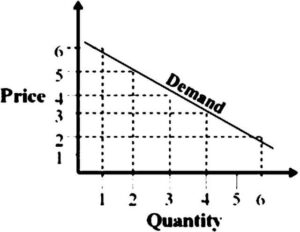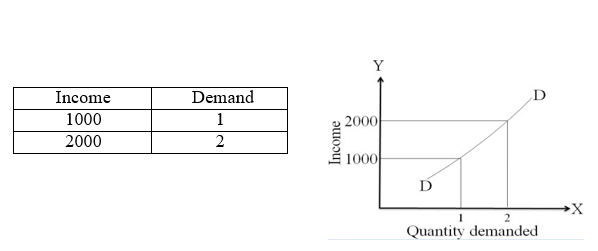Demand Analysis
In common parlance, demand means the desire for an object. But in economics demand is something more than this. According to Stonier and Hague, “Demand in economics means demand backed up by enough money to pay for the goods demanded”. This means that the demand becomes effective only if it is backed by the purchasing power. In addition to this, there must be willingness to buy a commodity.
Thus demand in economics means the desire backed by the willingness to buy a commodity and the purchasing power to pay.
In the words of Benham, “The demand for anything at a given price is the amount of it which will be bought per unit of time at that price”.
Hence, demand refers to the amount of commodity which an individual consumer is willing to purchase at a given price in a given period. The demand is said to exist when the following three conditions are fulfilled:
1. Desire to purchase
2. Ability to pay
3. Willingness to pay
Ex: A beggar may have desire to purchase a car but he cannot pay money for it.
Ex: A miser does not purchase a car but he can pay money for it.
Demand Function
Demand function is a function which describes a relationship between one variable and its determinants. The demand function for a good relates the quantity of good which consumers demand during a given period to the factors which influence the demand. Quantity demanded is the dependent variable and all the factors are independent variables. The factors can be built up into a demand function. The demand function can be mathematically expressed as follows:
Q = f(P, I, T, P1..Pn, EP, EI, A, O)
Q = Quantity demanded
f = Function of
P = Price of goods itself
I = Income of consumers
T = Taste and preferences
P1..Pn = Price of related goods
EP = Expectation about future price
EI = Expectation about future income
A = Advertisement
O = Other factors
Determinants Of Demand
There are several factors or determinants that affect the individual demand and market demand for a product. These factors are economic, social as well as political factors. The effect of all the factors on the amount demanded for the commodity is called Demand Function. These factors are as follows:
1. Price of the Commodity:
The most important factor affecting amount demanded is the price of the commodity. The amount of a commodity demanded at a particular price is more properly called price demand. The relation between price and demand is called the Law of Demand. The demand for a commodity varies inversely with its price. A decrease in price increases the purchasing power of consumers and an increase in the price decreases the purchasing power of the consumers.

2. Income of the Consumer:
The second most important factor influencing demand is consumer income. Individual consumer’s income determines his purchasing ability. When other things remaining constant, if income increases, demand increases and vice-versa. An increase in income makes an individual to buy many commodities. The effect of income on demand can be analysed for normal goods, perishable goods and inferior goods.
a) Normal goods: Usually, the demand for a normal good goes in the same direction with consumer’s income i.e., demand for normal goods is directly related to consumer’s income.
b) Perishable goods: For perishable goods like foods, fruits, meat, vegetables, milk, etc., whose life is very short, the quantity demanded raises with an increase in income, but after a certain level it remains constant even though the income raises.

c) Inferior goods: The goods for which the demand decreases even though the income level increases are inferior goods or cheap goods or ordinary goods.

3. Prices of related goods:
In a given market, if the price of one good influences the quantity demanded of another good, these two goods are said to be related goods. Two commodities in a given market are related to each other either as Substitutes or Complementary goods.
a. Substitutes: When a want can be satisfied by alternative similar goods, they are said to be substitutes to each other. Ex: Tea and Coffee, Santhoor soap and Lux soap, etc. The below graph indicates that as the price of coffee increases, the demand for tea increases. There is a direct relation between the price of coffee and the demand for tea.

b. Complementary goods: When a want can be satisfied by two or more goods in a combination, these goods are termed as complementary goods. In other words, if the price of one good increases, the demand for another good will decrease. Ex: Bread and Butter, Pen and Ink, Car and Petrol, Sugar and Tea, and Shoe and Socks, etc. The below table and graph indicate the indirect relationship between the price of one good and the demand for another good.
 </border=>
</border=>4. Tastes and habits of the Consumers:
Irrespective of the price of a good and income levels of consumers, demand for many goods depends on consumers’ tastes and habits. For example, the demand for ice-creams, chocolates, alcohol, tea, cigarettes, etc. depends on individual tastes and habits. In cases like these, a strict vegetarian does not demand meat at any price, whereas a non-vegetarian will buy meat at any price.
5. Wealth:
The amount demanded of a commodity is also affected by the amount of wealth as well as its distribution. The wealthier the people are, the higher is the demand for normal commodities. If wealth is more equally distributed, the demand for necessaries and comforts is more. On the other hand, if some people are rich while the majority are poor, the demand for luxuries is generally higher.
6. Population:
Increase in population increases demand for the necessaries of life. The composition of the population also affects demand. Composition of population means the proportion of young and old and children as well as the ratio of men to women. A change in the composition of population has an effect on the nature of demand for different commodities.
7. Government Policy:
Government policy affects the demands for commodities through taxation. Taxing a commodity increases its price and the demand goes down. Similarly, financial help from the government increases the demand for a commodity while lowering its price.
8. Expectations regarding future prices and incomes:
If consumers expect changes in the price of a commodity in the future, they will change the demand at present even when the present price remains the same. Similarly, if consumers expect their incomes to rise in the near future, they may increase the demand for a commodity just now.
9. Climate and weather:
The climate of an area and the weather prevailing there has a decisive effect on consumers’ demand. In cold areas, woolen cloth is demanded. During hot summer days, ice is very much in demand. On a rainy day, ice cream is not so much demanded.
10. State of business:
The level of demand for different commodities also depends upon the business conditions in the country. If the country is passing through boom conditions, there will be a marked increase in demand. On the other hand, the level of demand goes down during a depression.
